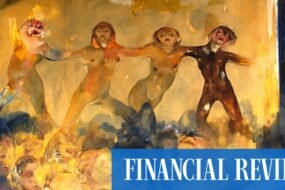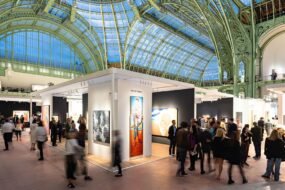
Jul. 20—As a child, Ashley Montoya spent her summer running around the Traditional Spanish Market while her grandmother ran a booth. Now, she’s the one behind the booth.
“I’m not sure how old I was when I first went, but as far as I can remember, my grandma has been doing the Spanish Market,” Montoya said.
Montoya will be among the artists at the Traditional Spanish Market representing decades and generations of skill.
The market will take place from 8 a.m. to 5 p.m. Saturday, July 26, and Sunday, July 27, on the Santa Fe Plaza. The market features artwork ranging from tinwork to weaving to pottery and much more.
“It’s really important to us to showcase these traditional art forms from the Spanish colonial period here in New Mexico,” Brissa Chilton-Garcia, market program coordinator, said.
Juanito Jimenez, who paints retablos, is celebrating 50 years at the market and has seen how it not only represents traditional art forms, but also the community.
“I see the market as an anchor event in the capital city, keen to perpetuate the true essence of Santa Fe and New Mexico …” Jimenez said. “As an artist, I just don’t look at the economy art does. Art is a central part of who we are as a people, united, working toward a future reconciliation, hope and eternal heritage.”
Eliana Barela is gearing up for her second year in the market and says it is an honor to be surrounded by fellow artists.
“Many of them are masters, and I feel so honored to be surrounded by the best of the best …,” Barela, who paints retablos, said. “It’s really inspiring. It’s motivating, and they’re so helpful and so willing to share their knowledge.”
The market connects masters with younger artists in an attempt to pass on the generational knowledge with an adjacent youth market, Chilton-Garcia said.
“They learn the artistic, cultural heritage in addition to entrepreneurial skills. So it’s ground up,” Chilton-Garcia said. “We have from as young as 7 years old, and then we have Traditional Spanish Market artists that have been with us for 50 years.”
Where some learn from assigned mentors, Montoya has been taught to weave by her family. This familial art form dates back to her great-great-grandmother, who learned it from her husband, a Chimayó weaver, decades ago.
“I believe I’m still learning a lot. It’s big footsteps to follow. But at the same time, it makes me very proud that I’m continuing our family tradition,” Montoya said.
The art form has been woven so deeply into Montoya’s life that she did not realize it was not an intrinsic part of everyone’s lives.
“Since I was a kid, I never realized not all grandmas weave because I had my great-great-grandma, my great-grandma and my grandma and my mom, they were all weavers,” Montoya said. “So I just kind of assumed, like that was just part of life.”
Montoya sold at the market for the first time in 2024. While Montoya was celebrating her first, her grandmother was saying it would likely be her last market.
“It was really bittersweet, (I was) proud to be there, proud to be able to jury in and be there with my sister,” Montoya said. “But a little bittersweet knowing that might be my grandma’s last market. So it was great, I got to have them there.”
Where Montoya has seen generations of artists in her family, Jimenez has seen generations come through the market, all of whom, he says, were “devotional on their part to this art form.”
“Every time that I go to the Spanish Market, I’m underneath the portal, and I look and I see the faces of these individuals who were there long before these young artists,” Jimenez said. “And I always thank these old artists because they saw the importance of this art form.”
Jimenez names past greats who sold at the Traditional Spanish Market, Horacio Valdez and Frank Brito, both of whom have art in the Smithsonian American Art Museum.
Over nearly 100 years, the market has grown larger and larger, yet it holds tight to its founding mission, according to Chilton-Garcia.
“The Traditional Spanish Market originally started in 1926 as a market to showcase Hispanic artists in New Mexico,” Chilton-Garcia said. “So we still stay true to that.”
Barela also found her way to the market through her family, recognizing the importance of the market’s mission. Her uncle used to participate as a seller before he died.
“After my uncle passed away, going to his funeral, I saw all the santeros there and they had built his casket for him, and he was buried with a retablo,” Barela said. “And I just sort of saw how important the art form was to the community and the culture.”
Santeros are artists dedicated to creating religious depictions and works, who Barela says are “a whole community.”
The market has a focus on religious artworks, such as retablos, and also features a dedicated Mass at 9 a.m. Sunday, July 27, at the Cathedral Basilica of St. Francis de Assisi, accompanied by a procession and a blessing of the artists.
“That was such a beautiful part of the market. I think it’s very special, specifically in Catholicism, like processions are a big part of the faith itself,” Barela said. “So for that to be surrounding the art and my art, it was so special to be a part of.”
Jimenez says he loves painting religious works, including retablos, because he feels a connection to the saints he paints.
“They become a part of me and the spiritual embodiment with the image is essentially my way of working,” he said.
For many of the artists, it is not just a connection to the art but to the history and tradition. Montoya learned weaving from her grandmother later in life. She had initially been against following in the footsteps of her ancestors, but changed her mind.
“My grandma, the one that I’m learning weaving from, actually didn’t start until she was about my age. Because she didn’t want to be like them either,” Montoya said. “And then when she got older, she had an appreciation for weaving, and she put five of her kids through college that way.”
The market receives visitors from all over the world, according to Chilton-Garcia.
“We have people from New Mexico. We have people from out of state, from other countries, coming to experience the culture” Chilton-Garcia said.
Aside from selling to and connecting with visitors throughout the two-day market, the sellers find family among other artists, according to Barela.
“There’s a whole community of market artists, and every show we have throughout the year is like a family reunion,” Barela said.
Chilton-Garcia hopes the market will keep finding and showcasing new artists.
“We’re looking for it to remain healthy, to keep the audience coming, and to keep on passing down the traditions, ensuring that we’re passing it on to the next generation,” Chilton-Garcia said.









